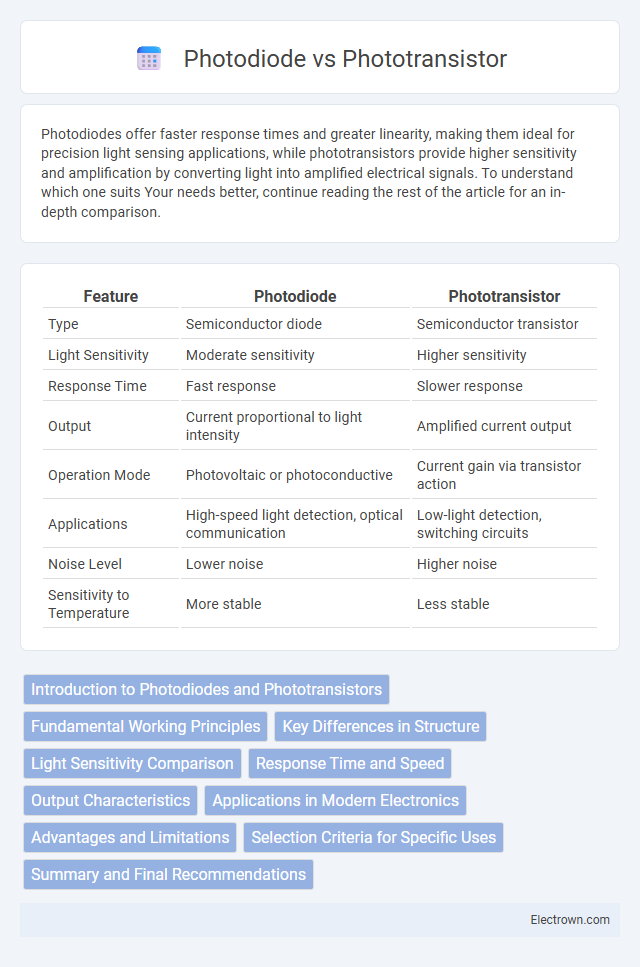Photodiodes offer faster response times and greater linearity, making them ideal for precision light sensing applications, while phototransistors provide higher sensitivity and amplification by converting light into amplified electrical signals. To understand which one suits Your needs better, continue reading the rest of the article for an in-depth comparison.
Table of Comparison
| Feature | Photodiode | Phototransistor |
|---|---|---|
| Type | Semiconductor diode | Semiconductor transistor |
| Light Sensitivity | Moderate sensitivity | Higher sensitivity |
| Response Time | Fast response | Slower response |
| Output | Current proportional to light intensity | Amplified current output |
| Operation Mode | Photovoltaic or photoconductive | Current gain via transistor action |
| Applications | High-speed light detection, optical communication | Low-light detection, switching circuits |
| Noise Level | Lower noise | Higher noise |
| Sensitivity to Temperature | More stable | Less stable |
Introduction to Photodiodes and Phototransistors
Photodiodes and phototransistors are semiconductor devices that convert light into electrical signals, playing critical roles in optical sensing and communication. A photodiode operates by generating a current proportional to the incident light intensity, with fast response times and linearity ideal for precision applications. Phototransistors amplify the photocurrent internally, offering higher sensitivity but slower response, making them suitable for detecting low light levels in your electronic projects.
Fundamental Working Principles
Photodiodes convert light into electric current using the photoelectric effect where photons generate electron-hole pairs, allowing for fast and linear response in light detection. Phototransistors operate similarly but amplify the current internally through a transistor action, resulting in higher sensitivity but slower response time compared to photodiodes. Your choice depends on whether speed or sensitivity is more crucial for your specific light sensing application.
Key Differences in Structure
Photodiodes consist of a simple p-n junction designed to convert light into current with high speed and linearity, while phototransistors incorporate an additional transistor structure providing internal gain to amplify the photocurrent. Photodiodes operate primarily in photovoltaic or photoconductive modes, whereas phototransistors leverage base current modulation, resulting in higher sensitivity but slower response time. The compact and straightforward design of photodiodes makes them ideal for high-speed applications, whereas the more complex phototransistor structure suits low-light detection with amplified output.
Light Sensitivity Comparison
Phototransistors exhibit higher light sensitivity compared to photodiodes due to their internal amplification capabilities, allowing them to detect lower light levels more effectively. Photodiodes respond faster with less noise, making them suitable for high-speed applications where precise light detection is necessary. In low-light environments, phototransistors provide stronger output signals, while photodiodes excel in applications requiring quick and linear light response.
Response Time and Speed
Photodiodes exhibit faster response times and higher speeds than phototransistors due to their simpler structure and direct photocarrier generation, making them ideal for high-frequency applications. Phototransistors, while more sensitive, have slower response times caused by inherent transistor gain and carrier recombination delays. In high-speed optical communication systems, photodiodes are preferred for their rapid signal detection capabilities.
Output Characteristics
Photodiodes exhibit linear output characteristics with current proportional to incident light intensity, providing fast response times and high accuracy in low-light conditions. Phototransistors amplify the photocurrent internally, resulting in higher sensitivity and larger output signal but slower response times compared to photodiodes. The output of photodiodes is typically measured as photocurrent, while phototransistors produce an amplified collector current, making them suitable for applications requiring higher gain.
Applications in Modern Electronics
Photodiodes are widely used in fiber optic communication systems, solar energy harvesting, and medical devices due to their fast response time and linearity. Phototransistors find applications in light detection, position sensing, and optoisolators where higher sensitivity and amplification are required. In modern electronics, photodiodes excel in high-speed data transmission, while phototransistors dominate in low-light and signal amplification scenarios.
Advantages and Limitations
Photodiodes offer faster response times and higher linearity, making them ideal for high-speed optical communication systems, but they generate lower current output, requiring amplification. Phototransistors provide greater sensitivity and higher current gain, enhancing detection in low-light conditions, yet they have slower response times and increased noise compared to photodiodes. Your choice depends on whether speed or sensitivity is more critical in your application.
Selection Criteria for Specific Uses
Photodiodes offer faster response times and higher linearity, making them ideal for high-speed optical communication and precise light measurement. Phototransistors provide greater sensitivity and amplification, suitable for low-light detection and applications requiring higher output signals without external amplification. Your choice depends on whether speed and accuracy or sensitivity and signal strength are the primary requirements for your specific use case.
Summary and Final Recommendations
Photodiodes offer faster response times and higher accuracy, making them ideal for applications requiring precise light detection and high-speed performance. Phototransistors provide greater sensitivity and amplification, suitable for low-light environments but with slower response rates. For high-speed, precise optical sensing, photodiodes are recommended, while phototransistors are better for detecting weak light signals with built-in gain.
photodiode vs phototransistor Infographic

 electrown.com
electrown.com